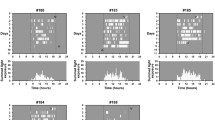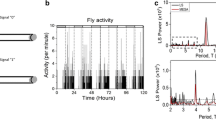Abstract
ANALYSIS of entrainment in circadian systems depends on a knowledge of the phase resetting effects of the light (or temperature) pulses perturbing the circadian oscillation. Thus when a light pulse of a particular intensity and/or duration falls at certain phases of the free-running oscillation it may generate phase-advances (+Δφ) in subsequent activity; when it falls at other phases it may generate phase-delays (−Δφ). A plot of such phase changes, both magnitude and sign, as a function of the phase of the oscillation so perturbed, is called a phase response curve (PRC) (refs 1, 2). In a systematic study of the resetting effects of light pulses on the rhythm of pupal eclosion in Drosophila pseudoobscura, Winfree3 demonstrated two topologically different types of PRC, depending on the strength of the signal. When light pulses were ‘weak’ (< 50 s blue light, 10 µW cm−2) phase shifts were small. When pulses were ‘strong’ (> 50 s) phase shifts became abruptly larger, up to 10–12 h. Because of the way Winfree's data were graphically presented, weak resetting curves were called type 1 and strong curves type 0. An abrupt change from type 1 to type 0 has been observed only in circadian systems which control physiological events such as pupal eclosion (refs 1–3 and D.S. in preparation) and oviposition5 in populations of insects. Rhythms of locomotor activity in single animals, on the other hand, have only shown low amplitude type 1 curves6,7. Entrainment in ‘physiological’ rhythms is in most cases mediated by extraoptic photoreceptors and a hormonal output8. ‘Behavioural’ rhythms, on the other hand, most frequently involve entrainment by way of the organised photoreceptors9,10 and an electrical (neural) output10–12. Truman used these differences to distinguish two types of biological clock13. Here, however, we report PRCs which switch from type 1 to type 0 in the locomotor activity rhythm of a cockroach Nauphoeta cinerea, which might from earlier literature have been expected to show only type 1 resetting.
Similar content being viewed by others
References
Pittendrigh, C. S. in Circadian Clocks (ed. Aschoff, J.) 277–297 (North-Holland, Amsterdam 1965).
Aschoff, J. in Circadian Clocks (ed. Aschoff, J.) 95–111 (North-Holland, Amsterdam, 1965).
Winfree, A. T. J. theoret. Biol. 28, 327–374 (1970).
Saunders, D. S. J. comp. Physiol. 110, 111–133 (1976).
Minis, D. H. in Circadian Clocks (ed. Aschoff, J.) 333–343 (North-Holland, Amsterdam, 1965).
De Coursey, P. J. Cold Spring Harb. Symp. quant. Biol. 25, 49–55 (1960).
Pittendrigh, C. S. & Daan, S. J. comp. Physiol. 106, 223–355 (1976).
Truman, J. W. & Riddiford, L. M. Science 167, 1624–1626 (1970).
Loher, W. J. comp. Physiol. 79, 173–190 (1972).
Nishiitsutsuji-Uwo, J. & Pittendrigh, C. S. Z. vergl. Physiol. 58, 1–46 (1968).
Roberts, S. K., de F. J. comp. Physiol. 88, 21–30 (1974).
Brady, J. in Biochronometry (ed. Menaker, M.) 517–526 (National Academy of Sciences, Washington DC, 1971).
Truman, J. W. in Circadian Rhythmicity, Proc. int. Symp. Circ. Rhythmicity 111–135 (Pudoc, 1971).
Roberts, S. K., de F. J. cell. Comp. Physiol. 59, 175–186 (1962).
Wiedenmann, G. Z. Z. Naturforschung (in the press).
Author information
Authors and Affiliations
Rights and permissions
About this article
Cite this article
SAUNDERS, D., THOMSON, E. ‘Strong’ phase response curve for the circadian rhythm of locomotor activity in a cockroach (Nauphoeta cinerea). Nature 270, 241–243 (1977). https://doi.org/10.1038/270241a0
Received:
Accepted:
Issue Date:
DOI: https://doi.org/10.1038/270241a0
- Springer Nature Limited
This article is cited by
-
An effective model of endogenous clocks and external stimuli determining circadian rhythms
Scientific Reports (2021)
-
Formal properties of the circadian rhythm of locomotor activity in Japanese quail
Journal of Comparative Physiology ? A (1982)
-
Two peaks in the activity rhythm of cockroaches controlled by one circadian pacemaker
Journal of Comparative Physiology ? A (1980)





